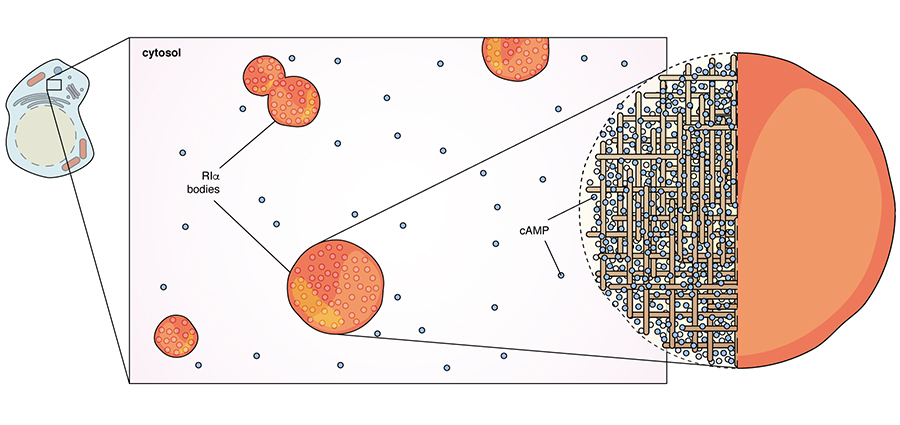Uncontrolled ‘cAMP’ Helps Spark Rare Liver Cancer
Scientists find that a protein binding to the molecule can form membraneless organelles, spurring rampant cell growth, tumors
Published Date
By:
- Cynthia Dillon
Share This:
Article Content
Since humans first controlled fire, they have camped around it to circulate information, signaling each other when something approaches. Metaphorically, certain molecules have been carrying information around our cells to help regulate bodily functions as needed. One such molecule, called cyclic AMP or “cAMP,” presumably travels freely inside cells managing these various processes. Uncannily it seems to show up at the right place and right time in response to environmental changes. How this small molecule does this is a mystery to scientists. So researchers at UC San Diego put their heads together to find out more.

The small molecule cAMP gets stuck in the crowded R1a bodies. Image courtesy of Jin Zhang, UC San Diego
With special interest in the implications cAMP presents for human health, the Department of Chemistry and Biochemistry’s Distinguished Professor Susan Taylor and Professor of Pharmacology Jin Zhang, along with their team at UC San Diego School of Medicine, in particular graduate student Jason Zhang (no relation to his mentor) and Assistant Project Scientist Sohum Mehta, engineered fluorescent tools that combine the gene editing technique CRISPR and biosensor technologies. These fluorescent probes helped the team look inside cells in a whole new way. What they found is, like a campfire must be controlled to avoid a serious blaze, uncontrolled cAMP can lead to a rare type of liver cancer called fibrolamellar carcinoma, or FLC. Their findings are published August 25, 2020 in Cell.
The scientists explained that cAMP and calcium are two of the most important second messenger signaling molecules in human cells. Their sites of action are typically finely orchestrated by binding proteins, kinases and scaffold proteins that create “communities” of signaling molecules.
“With the discovery of this new non-canonical mechanism for sequestering cAMP we build on the long standing tradition of Roger Tsien (the late UC San Diego chemist and Nobel Prize winner), who engineered some of the first fluorescent probes that allowed us to query events taking place in the cell. Clearly the story of cAMP signaling still has new chapters,” said Taylor.
Jin Zhang explained that cells are typically organized by membrane-enclosed organelles. These are like “rooms” within a factory where certain functions occur; for example the mitochondria, the “powerhouse” of the cell. So it surprised the scientists to discover that a major protein that binds to cAMP can form membraneless (no “walls”) organelles in cells through a process similar to how oil droplets form in water.
“We also found that cAMP is dynamically sequestered into these membraneless organelles. And when these structures are destroyed, cAMP floods the cell, leading to uncontrolled cell growth—an event that can lead to tumor formation,” she explained. “Our findings have provided a long-sought-after answer to the cAMP mystery.”
Professor Zhang said that most patients with FLC have a mutation where an important cAMP-regulated protein is joined to an unrelated protein. While this hybrid protein is known to drive the formation of FLC tumors, it is not known how it specifically leads to cancer.
“In this study, we showed that this cancer-causing fusion protein disrupts cAMP-containing membraneless organelles, allowing cAMP to flood the cell. Normal liver cells that have lost their capability to form these cAMP-containing membraneless organelles show uncontrolled cell growth, a hallmark of cancer. This study uncovers the mechanism underlying FLC and shows that uncontrolled cAMP can lead to cancer,” she said.
Like oil in water, RIα droplets (green dots in video) can merge. Video courtesy of Jin Zhang, UC San Diego
The scientists’ initial observation under the microscope of these liquid-like structures in cells—seeing how they coalesced and dissociated—was surprising and marked the beginning of their journey to the discovery. Along the way, they said they encountered even more surprises.
“We were surprised to find that these membraneless organelles, despite occupying less than 1 percent of the total volume in a cell, can soak up 99 percent of the cell’s cAMP,” said Jin Zhang. “We were also surprised to see that these cAMP-containing membraneless organelles are completely disrupted by the FLC cancer-causing fusion protein, which led to our unexpected discovery of a mechanism for its tumor-causing effect.”
According to the professor, since cAMP is important for every human cell—it is seen in membraneless organelles in cells of the brain, heart and pancreas—the team is now investigating the function of these dynamic structures in these specialized cell types.
“As various membraneless organelles formed in biological systems have attracted a lot of recent attention, a future direction is to look at what else is inside these structures and understanding the rules that allow molecules to enter and stay in these membraneless organelles,” she said. “Related to cancer, we are actively looking into the molecular basis by which uncontrolled cAMP leads to cancer.”
This study was supported by the National Science Foundation (DGE 1650112), a Taiwan MOE Scholarship, the Airforce Office of Scientific Research (FA 9559-18-1-0051) and the National Institutes of Health (R35 GM130389, R35 CA197622 and RO1 DKO73368).
Share This:
You May Also Like
Stay in the Know
Keep up with all the latest from UC San Diego. Subscribe to the newsletter today.



